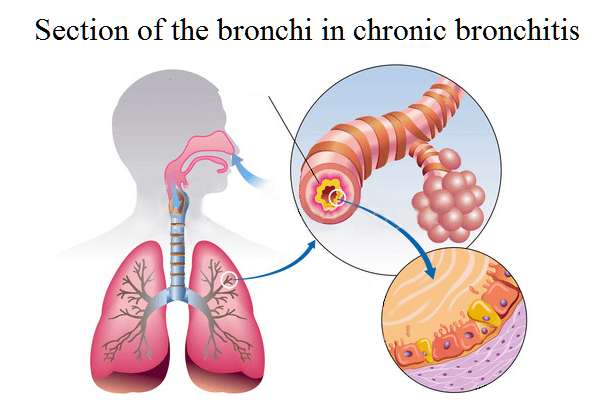Respiratory system >>>> Principles of chronic bronchitis treatment
Principles of chronic bronchitis treatment.

Under chronic bronchitis understand the process walls mucosal bronchial inflammation with rearrangement function mucosal secretions, sclerotic changes (substitution bronchus tissue on connective tissue) bronchial wall. In the later stages of the disease, atrophy of the mucous layer of the bronchi may develop.
The causes of chronic bronchitis are different, ranging from poorly treated acute bronchitis to the inhalation of harmful dust mixtures, gases, smoke, vapors of chemical compounds. Often this type of bronchitis occurs in people working in a harmful industrial atmosphere. It happens that chronic bronchitis appears as a complication in diseases of the upper respiratory tract: chronic tonsillitis , sinusitis , tracheitis, as well as in congestion in the pulmonary circulation, for example, in the case of heart failure. Statistics show that in recent years there has been a trend towards an increase in the number of cases of this serious disease.

The diagnosis of "chronic bronchitis" is given to those people who have had a cough for two years (lasting at least three months a year). But at the same time, they differentiate with other diseases of the respiratory tract (bronchial asthma , pneumonia, tuberculosis) and exclude them. A characteristic feature is a long course of the disease and periodic exacerbations. Exacerbation of chronic bronchitis can cause bacterial and viral infections.
Symptoms of chronic bronchitis are dry and wet cough (most often paroxysmal) with a small amount of sputum, shortness of breath, as well as impaired bronchial patency and ventilation. With an increase in painful symptoms, the production of sputum increases and its quality changes: from mucous to mucopurulent. The general state of health changes: there is increased fatigue, weakness, sweating, pain in the muscles of the chest and abdominal region, the temperature is normal or subfebrile (37 - 37.5). Against this background, bronchospasm may develop.
There are two forms of chronic bronchitis:
Non-obstructive bronchitis (or proximal), characteristic symptoms of which are considered to be cough with mucous and mucopurulent sputum, wheezing is heard.
Obstructive bronchitis (or distal) is an extremely serious violation of the function of the bronchi, leading to dangerous complications not only of the respiratory system (bronchospasm, acute or chronic pulmonary insufficiency), but also significantly disrupts the functions of the cardiovascular system (chronic pulmonary heart syndrome develops ). The characteristic symptoms of obstructive bronchitis are shortness of breath when walking, physical exertion, cough with mucopurulent sputum, wheezing rales are heard during deep breathing, which increase as the disease progresses, cyanosis appears (blue discoloration of the red border of the lips or skin).
Chronic bronchitis treatment should pursue several goals:
- Relief of emergency conditions
- Measures to slow the formation of pulmonary insufficiency syndrome and cor pulmonale
- Restoration of bronchial patency
Treatment of exacerbations of chronic bronchitis is carried out in two directions:
Antibiotic therapy is carried out only after bronchoscopy, washings, biopsy of the bronchial mucosa and microflora culture to determine the sensitivity to antibiotics.
According to recent studies, it is forbidden to prescribe antibiotics in the form of inhalation for treatment, as well as the use of antibiotics to prevent this disease, as this leads to the formation of bacterial resistance (resistance) and gives rise to the development of fungal infection.
Antibiotics are selected taking into account several factors:
- purulent discharge when coughing
- the presence of bacteria that most often cause exacerbation of the disease (H. influenzae, Str.pneumoniae, Bronchamella catarrahalis and others)
- the concentration of strains in the bacterial secretion must be high
- the drug should have the lowest possible toxicity and allergenicity
Antitussive therapy (expectorant and thinning phlegm):
- Expectorants and bronchodilators are prescribed.
- With bronchospasm, bronchodilators are used (atrovent, berodual, theophylline), and if they are ineffective, glucocorticosteroids are prescribed.
- Chest massage, gymnastics of the respiratory muscles, physiotherapy (inhalation, electrophoresis, ultraviolet radiation of the chest).
Prevention of exacerbations of chronic bronchitis.
- To give up smoking.
- Fractional nutrition, excluding overeating - allows the diaphragm not to rise high, which reduces the amplitude of breathing and, accordingly, shortness of breath.
- Physical training of the respiratory muscles.
- Herbal medicine using expectorant herbal preparations to avoid congestion in the bronchi.
- Walks and rest in coniferous forests (phytoncides exuded by pine and spruce needles have an antiseptic effect and relieve bronchospasm).
- The sea air also has an antispasmodic effect.
- Inhalation with isotonic and hypertonic solutions of sodium chloride, sodium bicarbonate plus a few drops of menthol.
- Oil inhalations using almond, sea buckthorn, olive, eucalyptus oils (such inhalations are contraindicated for those working in a dusty atmosphere, as dust particles stick together with oil drops and clog the lumens in the bronchi).
It is impossible to achieve complete recovery, especially in the case of obstructive bronchitis in combination with pulmonary hypertension and respiratory failure, but it is possible to maintain the state of the body at an optimal level and improve the quality of life. It must be remembered that chronic bronchitis is a disease, the delayed treatment of which can cost lives.

Read

Read



























